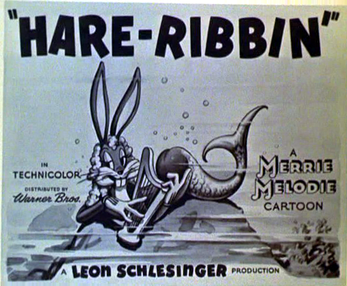Thank you for joining us today.
The next title that The ACME Eagle Hand Soap Radio Hour should have aired was Bugs Bunny Nips the Nips, a 1944 Looney Tune title, directed by Friz Freleng. This title is considered to be one of the most offensive wartime Warner Bros. cartoons in history. We struggled with whether or nor we would skip over this title. Although the cartoon itself has never been part of The Censored Eleven list to begin with, the title has had limited to no air time in nearly 30 years. Even though we have been trying to show all of the Bugs Bunny titles in order, we felt obligated not embedding this one (but we have linked to it here.) We mean no offense by linking to the title but felt we needed to for the sake of completion.
So all of that means that today, before our feature presentation, ACME would like to start the evening with another Bugs Bunny Looney Tunes cartoon, the 1944 Bob Clampett directed, Hare Ribbin':
This cartoon holds the distinction of having two endings, both of which are too violent by today's standards to be shown on children/family-friendly television. In both endings, the Russian Dog, distraught over Bugs' "death" and guilt-ridden, wishes he were dead too. Bugs then quotes the popular radio character of the day, the Mad Russian, saying, "eh, do you mean it?" After that scene comes one of two different scenarios:
The original theatrical ending: Bugs gives the dog a gun so he can commit suicide by shooting himself in the head — once played in theaters to a general audience, is now commonly cut from television versions on network and cable TV. The edit occurs between the scene where Bugs says "Do you mean it?" and the dog laying down, making it seem as if the dog had dropped dead out of guilt without shooting himself.
The "director's cut" ending: Bugs pulls out a gun, shooting the dog through the mouth. Bugs then dances away, and the dog gets up to deliver the last line: "This shouldn't happen to a dog." Other scenes included in the director's cut is an extended scene of the Dog sniffing for Bugs in the beginning of the film. Also when the dog turns around and sees Bugs in his mermaid costume, in the original cut the Dog turns into a torpedo right when Bugs whistles at him. The director's cut adds a scene where the dog starts heavy breathing before turning into a torpedo, with an extended version of them playing tag.
The ACME Eagle Hand Soap Radio Hour would like to celebrate the anniversary the passing of Frederick Emanuel Austerlitz on this date in 1987. Mr. Austerlitz and his sister had a successful 'brother and sister' dance act before Hollywood beckoned. Surprisingly, he survived the famous report of his screen test, "Can't act. Slightly bald. Also dances," to become one of Hollywood's most beloved musical stars. Today we would like to watch two examples from his very storied career - the 1936 movie musical, Swing Time and the 1958 television special, An Evening with Fred Astaire. So we would like you to sit back (quick, find the most comfortable seat on the sofa,) get a snack and a beverage and join The ACME Eagle Hand Soap Radio Hour in watching the first feature, the 1936 classic - Swing Time.
Fred Astaire always insisted that his dance routines be filmed in one continuous camera shot, showing the dancer(s) from head to foot. However, in the "Never Gonna Dance" number, there is an obvious moment when Astaire and Rogers reach the tops of their respective winding staircases that the camera shot changes quickly to reflect the fact that the filming camera had to be brought upstairs to shoot the close-up finale of the dance number.
I'm guessing that we could all use a break, right about now. So you can run into the kitchen and get a beverage refill or run into the bathroom and replenish the eco-system, while we watch another censored 1940s cartoon, this time a Big Bad wolf parody - the 1942 Tex Avery directed and MGM produced (Tex Avery’s first cartoon for MGM,) Blitz Wolf -
This short was an Academy Award nominee, though it lost to another anti-Nazi cartoon, The Walt Disney short, Der Fuhrer's Face .
Welcome back to The ACME Eagle Hand Soap Radio Hour and as you remember we're celebrating the life of Fred Astaire by watching some programs featuring his dancing. Next up, a TV special from 1958, produced by NBC, An Evening with Fred Astaire. So sit back, relax and enjoy our second feature. -
This special was the first color show pre-recorded on videotape at NBC's new state-of-the-art "Color City" studios in Burbank, California. It is the second-oldest surviving color program to be recorded on videotape; the oldest known color videotape is the May 1958 inauguration of NBC's Washington, D.C. color studios.
Demand Euphoria!

No comments:
Post a Comment